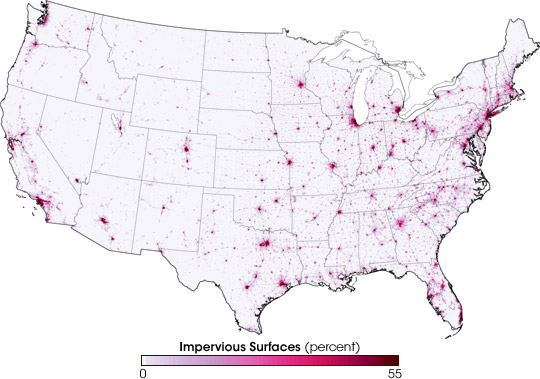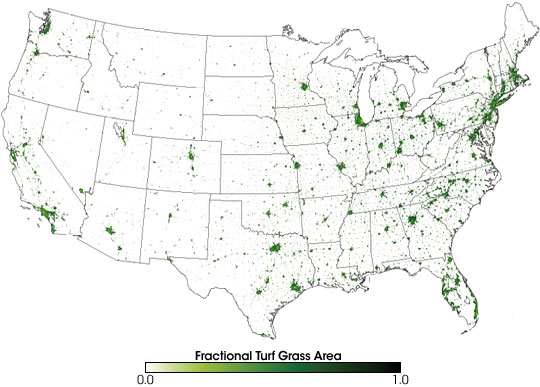| |
More Lawns than Irrigated Corn |
| |
Although there was little in the way of published research on estimating U.S. lawn area, the research group Milesi was studying and working with at the University of Montana had a lot of experience with using satellite data to observe and model natural ecosystems like forests and grasslands. At first, it might seem like creating a national map of lawn surface area ought to be an easy task to accomplish with satellites. Unfortunately, the scale of most lawns is smaller than most satellites can observe. The satellites that can identify such small areas only observe small areas at a time, and the images they collect are expensive. It would cost too much to buy and take too long to analyze the large number of high-resolution (very detailed) satellite images or aerial photos that someone would need to buy to map every lawn in the country. |
|
  |
| |
 |
| |
Instead, Milesi needed to identify a relationship between lawn area, which she didn’t know, and some other characteristic about urban areas that was either already known, or at least easier to estimate from satellite images. She and her colleagues worked backward from the assumption that amount of lawn area would decrease as the amount of impervious surface increased. Impervious surfaces are surfaces that don't absorb water, such as roads, roofs, parking lots, and sidewalks. |
|
Impervious surfaces cover a large percentage of urban land area. The map above shows increasing percentage of impervious surfaces in darker shades of pink. Among the data used to identify impervious surfaces are satellite observations of city lights at night. (Map by Robert Simmon, based on data from Chris Elvidge, NOAA National Geophysical Data Center.) |
| |

Milesi and her colleagues combined the information about the distribution of urban areas from the U.S. Geological Survey’s National Land Cover Database, which is based on Landsat satellite data, with nighttime city light data, which are collected by a Department of Defense satellite, and analyzed and made publicly available by the National Ocean and Atmospheric Administration. It turns out that the brightness of nighttime lights in an area is a good indication of how much impervious surface there is. That isn’t surprising when you think about where we put lights in a city—along roads, sidewalks, and in and around buildings. |
|
Researchers predicted lawn surface area in urban and suburban settings from impervious surface area. In general, as impervious surface area such as roads and parking lots increases, lawn area decreases. Milesi and her team refined the predictions using aerial photography over different urban landscapes, such as this industrial location in Chicago. (Image courtesy Chris Elvidge.) |
| |

Milesi and her team refined the initial satellite-based estimates of impervious surfaces by carefully comparing them to aerial photos collected over 13 different metro areas. “Using the aerial photos, we identified a predictive ratio between impervious surface area and lawn area that was remarkably consistent across all the urban areas we analyzed,” she explains. |
|
The amount of impervious surface area changes from one part of a city to another. This residential area of Chicago is quite different from the industrial area shown above. However, Milesi and her colleagues found that the ratio of impervious surface area to lawn area was remarkably consistent in urban areas across the United States. (Image courtesy Chris Elvidge.) |
| |
 |
| |
In essence, they analyzed satellite and aerial imagery and came up with a formula that said, “If the impervious surface area is this much, then the lawn surface area is probably that much.” Then they applied their mathematical formula to the total impervious surface area in the United States.
“Even conservatively,” Milesi says, “I estimate there are three times more acres of lawns in the U.S. than irrigated corn.” This means lawns—including residential and commercial lawns, golf courses, etc—could be considered the single largest irrigated crop in America in terms of surface area, covering about 128,000 square kilometers in all. Her next task was to figure out some of the ecological impacts of this crop of lawns Americans are cultivating.
 Ecological Impact of Lawns Ecological Impact of Lawns
 Looking for Lawns Looking for Lawns
|
|
According to Milesi’s estimates, more surface area in the United States is devoted to lawns than to individual irrigated crops such as corn or wheat. This map uses shades of green to indicate the fraction of the U.S. land surface area covered by lawns, including residential, industrial, and recreational. (Map courtesy Cristina Milesi.) |

